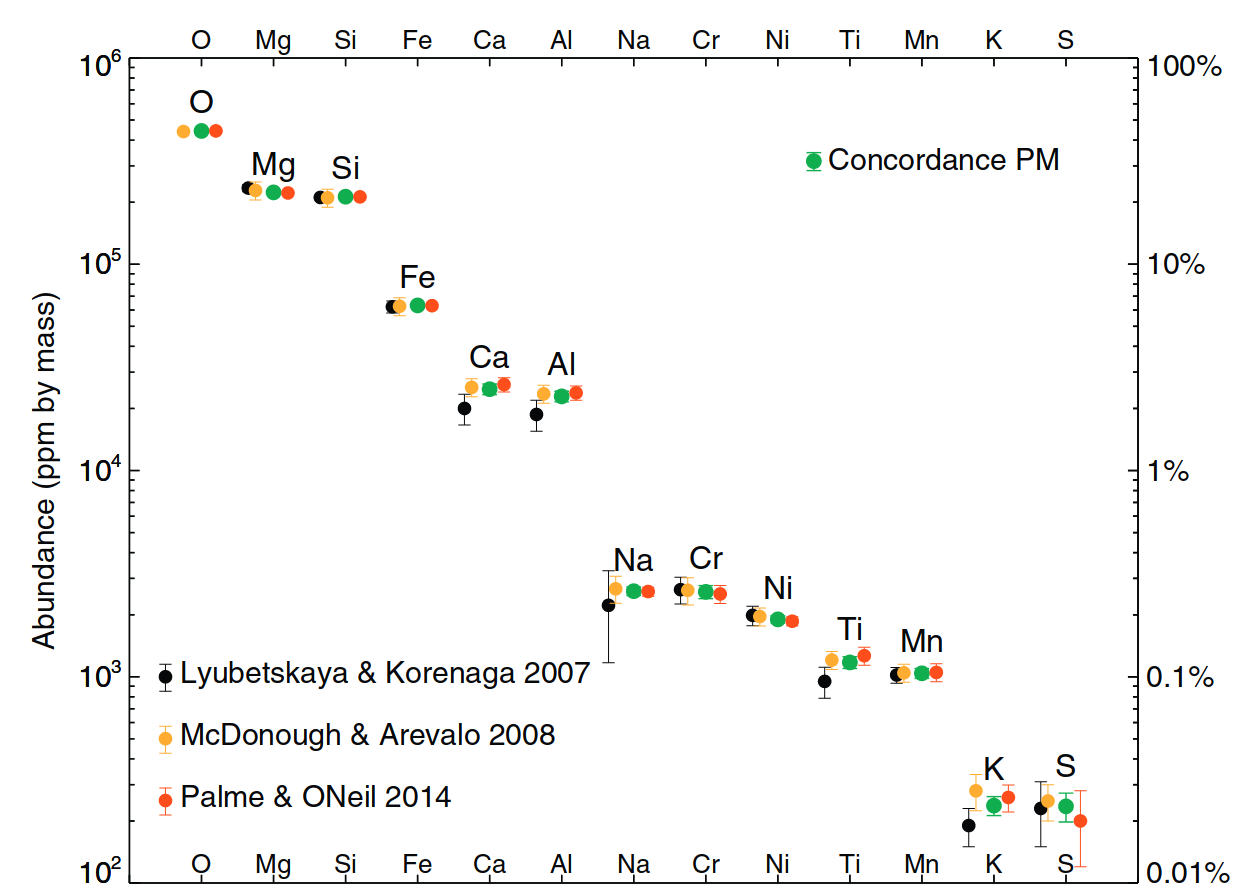Published on: 2023-12-22
Written by Nathan Pulver
- Metals, why they’re important, and what they typically look like
- Introduction to Manganese
- Closing remarks
- Sources
Metals, why they’re important, and what they typically look like
Before we get started with Manganese I think we should talk about metals , and why they’re important. In the context of Earth Science, transition metals make up a around 34% of the Earth by mass. This number is slightly misleading, because 31.2% of that is Iron, and most of that Iron is in the core. When thinking of the rocky part of the Earth that includes the crust and mantle, 7% of that is transition metals and again most of this being Iron. To see a clearer elemental breakdown, see the figure below.

Introduction to Manganese
The 25th element Manganese, just to the left of Iron, is a 3d5 transition metal. Transition metals are defined by their d orbital valence shell. There are 5 spots that can be filled in these orbitals, each spot can host two electrons, but they have to have opposite spins if they decide to share a spot. For most materials at ambient conditions, it turns out to be much easier to first put one electron in each spot, then if we want to take more electrons, we can start sharing orbitals but this isn’t as favorable energetically. In regards to Mn, 3d-5 means there are 5 electrons, so 1 in each electron parking spot and not sharing with anyone.
As previously mentioned, Manganese is one of the few exceptions to the transition metal structure “rules”. The stable ambient phase of Mn is shown in the cover photo of this article. It is a massive, 58 atom cubic unit cell (28 atom primitive cell). To put that into perspective, bcc structures are made up of a total of 2 atoms (one in the center, 1/4 in at all the corners), fcc structures are made up of 4 atoms ( 1/2 on each face, 1/4 on each corner). The structure is known as the A12 structure or simply the -Mn structure. Oddly, many computational examinations of Mn show an hcp phase stable at ambient conditions. Something about Mn is not being captured by these models. The bulk modulus, or how difficult it is to squish something, is also comparatively low for Mn. So what the heck is going on with Manganese?
According to a recent study by Hobbs et al, the reason for this strange structure has to do with the magnetic moments of Mn. Below the temperature 95K, Mn is antiferromagnetic, meaning that the magnetic moments are aligned but in an opposite direction to that of normal ferromagnets. In real terms, this means that at really cold temperatures, each Mn atom has alternating magnetic moments of equal magnitude. You can imagine this as a row of arrows with alternating up, down directions (note it is slightly more complicated than this in 3 dimensions). Above 95K Mn loses its ordered magnetism and while the crystal structure does not change, the magnetic one does dramatically. The new magnetic phase could be paramagnetic (no magnetic moments), or it could be a non-collinear antiferromagnetic phase (antiferromagnetic with magnetic moments pointing in odd directions) according to their modeling. If we consider the antiferromagnetic structure, we can also account for the bulk modulus of Mn. Those strange magnetic moments can repel each other and cause Mn to puff up in a way. This magnetic moments are relatively weak though, so that means it is really easy to squish Manganese, at least until we are past the limit of the strength of those magnetic moments.
Closing remarks
As we can see, Manganese is quite strange. I think there is still a lot of interesting questions to ask here. The main study by Hobbs et al that I highlighted is a computational one so it must be confirmed by experimental results. With the complex magnetic and electronic structure Mn exhibits, it may be interesting to see if it forms an electride at certain pressures and temperatures. The authors mention that the -Mn phase is equivalent at least topologically to the intermetallic phase but it is not clear to me if by mentioning that they think Mn exists in different valence states within the unit cell (Mn+1, Mn+3 etc.)or if it is just an interesting comparison. I am working on processing some experimental data of X-ray diffraction of Mn at elevated pressures and temperatures. To my knowledge, there are no studies of Mn at high temperatures above 4 GPa so there could be some interesting results in the data set.
Sources
- msestudent.com - Mostly for the second figure in this article
- Wikipedia - verified the structures of transition metals
- New description of metastable hcp phase for unaries Fe and Mn: Coupling between first-principles calculations and CALPHAD modeling, Bigdeli et al
- Understanding the complex metallic element Mn. I. Crystalline and noncollinear magnetic structure of α-Mn